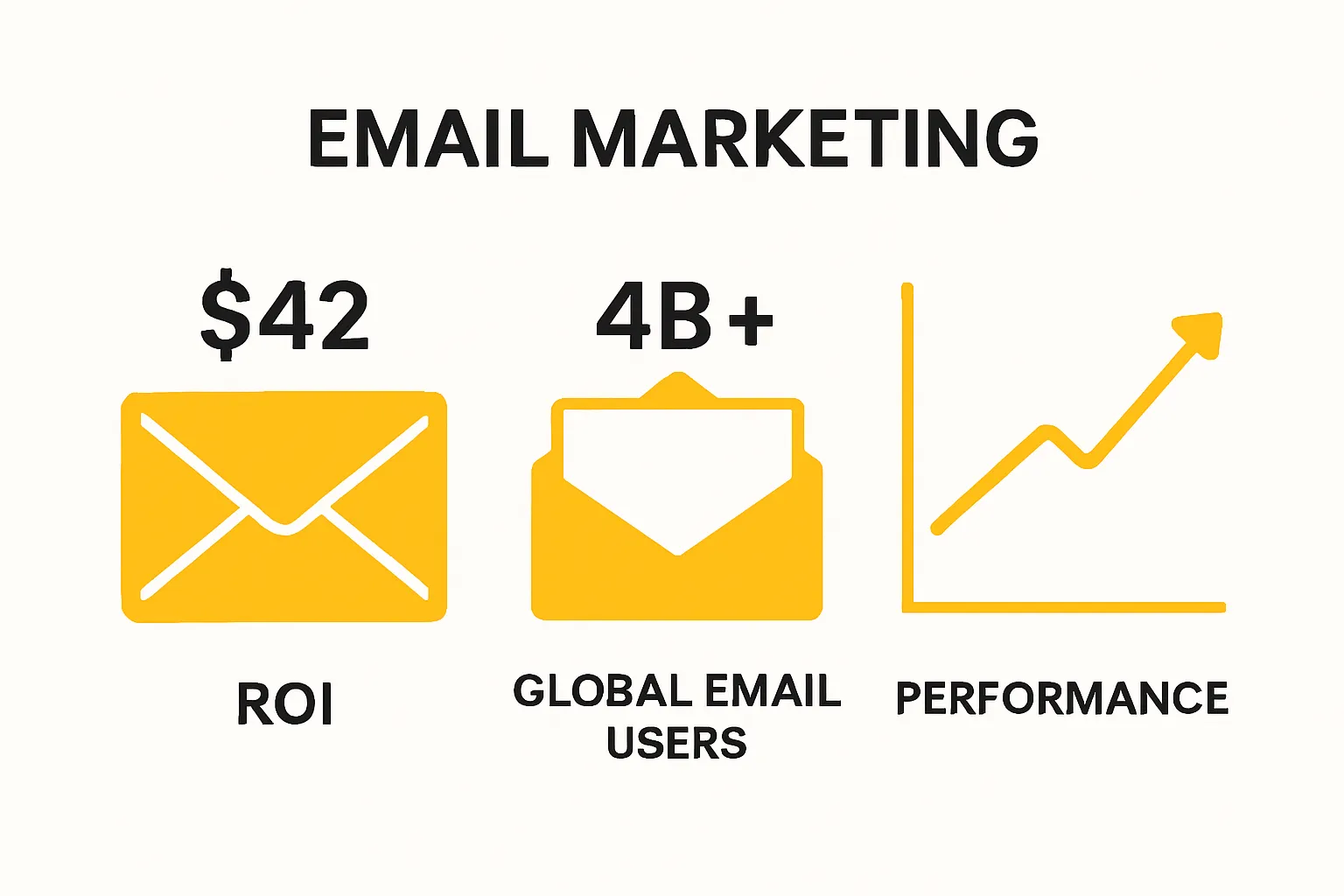Email Marketing Explained: Understanding Its Importance
- Eddie The Chef

- Oct 6
- 8 min read

Email marketing sounds like a boring inbox filler to some people and yet it’s one of the sharpest tools a business can use today. Surprised? The stats back it up. For every dollar spent on email marketing, you can rake in up to $42 in return. Hard to believe, right? Thing is, email marketing quietly outperforms just about every other digital channel when it comes to value and reach.
Table of Contents
Quick Summary
Takeaway | Explanation |
Email marketing offers high ROI. | Companies can expect to earn up to $42 for every $1 spent, indicating its cost-effectiveness. |
Build a quality email subscriber list. | A well-managed, engaged subscriber list can improve engagement rates by up to 40% over poorly maintained lists. |
Personalise your email content. | Tailored messages, specific subject lines, and strong calls-to-action increase engagement and encourage conversions. |
Utilise automation and segmentation. | Automated sequences and targeted messaging based on subscriber behaviour enhance relevance and engagement in campaigns. |
Monitor and analyse campaign performance. | Track open rates, click-through rates, and conversion metrics to refine strategies and boost marketing effectiveness. |
What is Email Marketing and How Does it Work?
Email marketing represents a powerful digital communication strategy where businesses send targeted messages directly to subscribers’ inboxes. Unlike traditional marketing channels, email marketing allows for precise, personalised communication that can drive engagement, sales, and customer loyalty.
Understanding the Basics of Email Marketing
At its core, email marketing involves sending commercial messages to a group of people who have voluntarily shared their contact details. These messages can range from promotional content and product announcements to newsletters and personalised offers. Learn more about email marketing strategies that can transform your digital communication approach.
The fundamental components of email marketing include:
Subscriber List: A database of email addresses from individuals who have opted to receive communications
Email Content: Carefully crafted messages designed to inform, engage, or prompt action
Email Service Provider: Platforms that help manage subscriber lists, design emails, and track performance
How Email Marketing Mechanics Work
The process of email marketing involves several strategic steps. Businesses first collect email addresses through website sign-ups, lead magnets, or in-store registrations. Once a subscriber joins the list, they receive carefully segmented and targeted communications.
According to Campaign Monitor, effective email marketing can generate up to $42 for every $1 spent, making it one of the most cost-effective marketing channels available to businesses.
Modern email marketing platforms offer sophisticated tools that enable businesses to:
Track open rates and engagement metrics
Automate email sequences
Personalise content based on subscriber behaviour
Segment audiences for more targeted messaging
Successful email marketing requires understanding your audience, delivering valuable content, and maintaining a consistent, professional communication strategy that respects subscriber preferences and privacy.
The Importance of Email Marketing for Businesses
Email marketing has emerged as a critical communication channel for businesses seeking cost-effective, direct, and measurable marketing strategies. Explore comprehensive video marketing approaches to complement your email communication efforts and create a robust digital marketing strategy.
Cost-Effective Marketing Solution
Unlike traditional advertising methods that require significant financial investment, email marketing offers an incredibly affordable approach to reaching customers. HubSpot research indicates that businesses can connect with their audience at a fraction of the cost of print, television, or radio advertising.
Key financial advantages include:
Minimal Production Costs: No printing or postage expenses
Scalable Reach: Ability to contact thousands of subscribers simultaneously
Low Investment, High Returns: Potential for substantial return on marketing expenditure
Direct Customer Engagement and Communication
Email marketing provides businesses with a unique opportunity to establish direct, personalised communication channels with their audience. Companies can segment their subscriber lists, create targeted messages, and track engagement metrics in real time.
According to Statista, over 4 billion people worldwide use email, representing an enormous potential audience for businesses across various industries.

Benefits of direct customer engagement through email include:
Building long-term customer relationships
Delivering timely and relevant information
Creating personalised marketing experiences
Maintaining consistent brand communication
Measurable Marketing Performance
One of the most significant advantages of email marketing is its inherent trackability. Modern email marketing platforms provide comprehensive analytics that allow businesses to understand subscriber behaviour, measure campaign effectiveness, and continuously refine their communication strategies.
Businesses can precisely track metrics such as:
Open rates
Click-through rates
Conversion rates
Subscriber growth
By leveraging these insights, organisations can make data-driven decisions and optimize their marketing efforts for maximum impact and engagement.
Below is a table outlining the key advantages of email marketing compared to traditional marketing channels referenced in the article.
Marketing Channel | Cost-Effectiveness | Audience Reach | Personalisation Capability | Measurability |
Email Marketing | High (up to $42 ROI per $1) | Global (4+ billion users) | Strong (segmentation, personalisation) | Precise metrics |
Print/TV/Radio Advertising | Low to Moderate | Broad but less targeted | Limited | Basic estimates |
In-Store Promotions | Moderate | Local/visiting audience | Some (face-to-face) | Difficult to track |

Key Components and Concepts of Successful Email Campaigns
Successful email marketing goes far beyond simply sending messages to a subscriber list. It requires strategic planning, understanding audience preferences, and implementing sophisticated techniques that drive engagement and conversions. Explore our comprehensive social media management insights to complement your holistic digital communication strategy.
Email List Building and Management
The foundation of any effective email campaign is a high-quality, permission-based subscriber list. According to EmailToolTester, businesses with well-managed email lists can see engagement rates up to 40% higher than those with poorly maintained databases.
Key considerations for list building include:
Organic Growth: Collecting emails through genuine opt-in methods
Quality Over Quantity: Focusing on engaged, interested subscribers
Regular List Maintenance: Removing inactive or bounced email addresses
Crafting Compelling Email Content
Email content determines whether subscribers will engage with your message or quickly dismiss it. Successful campaigns require a delicate balance of informative, relevant, and visually appealing content that speaks directly to the audience’s interests and needs.
Essential elements of effective email content include:
Personalized subject lines
Clear and concise messaging
Strong, action-oriented call-to-actions
Mobile-responsive design
Visual consistency with brand identity
Advanced Segmentation and Automation Strategies
Modern email marketing transcends generic mass communication. Advanced segmentation allows businesses to deliver highly targeted content based on subscriber behaviour, demographics, and interaction history.
Automation tools enable businesses to:
Create triggered email sequences
Implement behavioural targeting
Develop personalised customer journeys
Implement sophisticated re-engagement campaigns
By understanding and implementing these key components, businesses can transform email marketing from a simple communication tool into a powerful driver of customer engagement and revenue growth.
The table below summarises the core components of successful email marketing campaigns as described within this section.
Component | Description |
Subscriber List | A permission-based database of individuals who opted in to receive emails |
Email Content | Well-crafted, relevant, and mobile-friendly messages designed to engage |
Email Service Provider | Platform used to manage lists, design emails, and monitor performance |
Segmentation | Dividing subscribers into groups for targeted and personalised messaging |
Automation | Setting up automated sequences and triggers based on subscriber behaviour |
Performance Tracking | Analysing open rates, clicks, conversions, and subscriber activity |
How Email Marketing Integrates with Other Marketing Strategies
Email marketing is not an isolated strategy but a powerful component of a comprehensive digital marketing ecosystem. Discover our ultimate business marketing strategy recipe to understand how different marketing channels can work synergistically.
Cross-Channel Marketing Synergy
Successful modern marketing requires a holistic approach where different channels complement and reinforce each other. According to McKinsey, businesses with integrated marketing strategies see up to 20% higher overall marketing performance.
Key integration points include:
Social Media Amplification: Using email to drive social media engagement
Content Marketing Support: Distributing blog posts and resources via email
Retargeting Campaigns: Coordinating email messaging with digital advertising
Leveraging Email in Multichannel Customer Journeys
Email marketing serves as a critical touchpoint that connects various stages of customer interaction. It can bridge experiences across digital and offline channels, providing consistent messaging and nurturing leads through personalised communication.
Strategic integration methods involve:
Connecting website interactions with targeted email campaigns
Using email to complement video marketing efforts
Synchronising offline event communications with digital outreach
Creating seamless customer experience across multiple platforms
Data-Driven Marketing Ecosystem
Modern email marketing platforms offer sophisticated integration capabilities that allow businesses to create interconnected marketing ecosystems. These tools enable real-time data sharing, automated trigger responses, and comprehensive customer insights.
Advanced integration capabilities include:
CRM system synchronisation
Automated workflow triggers across platforms
Unified customer data collection
Cross-platform performance tracking
By treating email marketing as an integral part of a broader marketing strategy, businesses can create more cohesive, engaging, and effective communication approaches that resonate with their target audience.
Challenges and Opportunities in Email Marketing
Email marketing continues to evolve, presenting businesses with complex challenges and exciting opportunities for growth and engagement. Learn about the fascinating evolution of publication advertising to understand how marketing communication strategies have transformed over time.
Navigating Privacy and Compliance Challenges
In an era of increasing digital privacy concerns, email marketers must carefully balance effective communication with regulatory compliance. GDPR and similar regulations have fundamentally reshaped how businesses collect, manage, and communicate with subscriber data.
Key compliance considerations include:
Explicit Consent: Obtaining clear permission before sending emails
Transparent Data Handling: Clear communication about data usage
Easy Unsubscribe Mechanisms: Simple opt-out processes for subscribers
Data Protection Standards: Implementing robust security measures
Technological Disruption and Adaptation
Rapid technological advancements continually reshape email marketing landscapes. According to Litmus, email client diversity and changing user behaviors require constant strategic adaptation.
Emerging opportunities and challenges include:
Artificial intelligence driven personalization
Advanced email design and interactivity
Increased mobile email consumption
Sophisticated segmentation technologies
Enhanced predictive analytics
Engagement and Deliverability Complexities
Modern email marketing demands sophisticated strategies to cut through increasing digital noise and avoid spam filters. Businesses must develop nuanced approaches that prioritize genuine value and relevance.
Strategic approaches to maintaining high engagement include:
Creating hyper-personalized content
Implementing intelligent send-time optimization
Developing sophisticated segmentation strategies
Maintaining consistently high-quality email lists
Monitoring and improving sender reputation
Successful email marketing now requires a holistic approach that combines technological understanding, strategic creativity, and unwavering commitment to delivering genuine value to subscribers.
Ready to Turn Email Marketing Obstacles into Opportunities?
Many regional businesses struggle to make their email marketing truly work. You might be facing low engagement, scattergun messaging or simply overwhelmed by the tech. This article highlighted key challenges like effective list management, the need for personalised content and making your campaigns actually deliver results. If you want genuine customer connections and measurable growth, but feel stuck or outpaced by bigger competitors, you are not alone.

Let the team at Marketing Recipes Australia help you cut through the clutter with tailored email strategies and hands-on support. Experience our holistic approach that blends email marketing with options like video marketing and social media management, designed especially for regional businesses. Take the first step to stronger engagement and bigger returns by exploring our proven digital marketing solutions today. Visit the Marketing Recipes Australia homepage to chat with our experts and start transforming your email results now.
Frequently Asked Questions
What is email marketing?
Email marketing is a digital communication strategy that involves sending targeted messages directly to subscribers’ inboxes. It allows businesses to communicate effectively, promote products, and engage with customers in a personal manner.
How does email marketing work?
Email marketing works by collecting voluntary subscriptions from users who provide their email addresses. Businesses then send crafted messages that can include promotions, newsletters, and personalized offers to these subscribers.
Why is email marketing important for businesses?
Email marketing is important because it is a cost-effective way to reach a large audience, facilitates direct and personalized communication, and provides measurable performance metrics to help refine marketing strategies.
What are key components of a successful email marketing campaign?
Key components include building a quality subscriber list, crafting compelling and relevant email content, and implementing advanced segmentation and automation strategies to enhance engagement and conversions.
Recommended
Comments